White chicken breeds are among the most common as they’re likely to be spotted in almost every coop. These chickens are not only known for their beauty but also for their superb meat and egg production. So what are some of the popular types of white chicken breeds?
Here are some of the popular types of white chicken breeds:
- White Leghorn
- White Araucana
- White Ameraucana
- Rhode Island White Chicken
- California White Chicken
- Yokohama Chicken
- Sultan Chicken
- White Plymouth Rock Chicken
Most white chickens tend to have good meat sizes and egg-producing qualities, with a lot of them being easy to maintain. This article will examine some of the most popular white chicken breeds, paying special attention to their origins, features, and characteristics.
8 Popular Types of White Chicken Breeds
1. White Leghorn
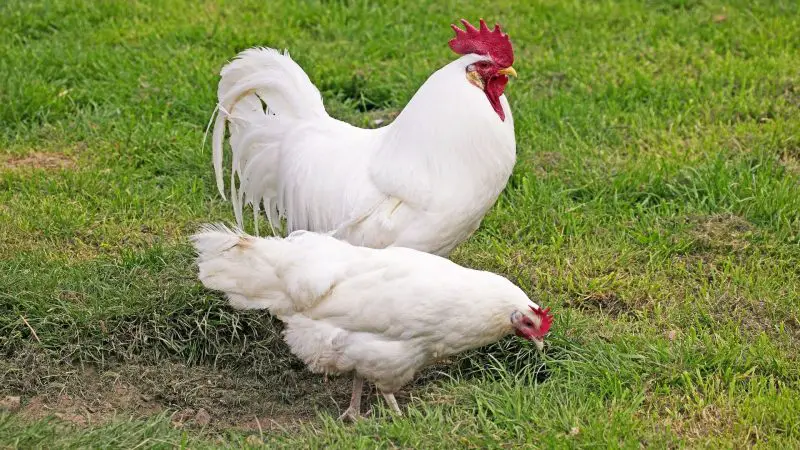
White Leghorns originated from Italy, around the Livorno Port area in Leghorn. Their sub-varieties were later bred in England, America, and Denmark. Breeders brought them to America in the 1820s.
These breeds have a solid white plumage, with yellow skin and legs. They are small in size and are revered for their hardiness, a feature that allows them to thrive even in less suitable conditions.
Best For:
This fowl’s small size makes it less ideal for meat production. However, don’t be fooled by the miniature size, though, as these fowls can produce around 300 eggs a year. They start laying when they’re around five months old and tend to produce eggs with white eggshells. This explains why the White Leghorn are mostly bred for egg production.
2. White Araucana
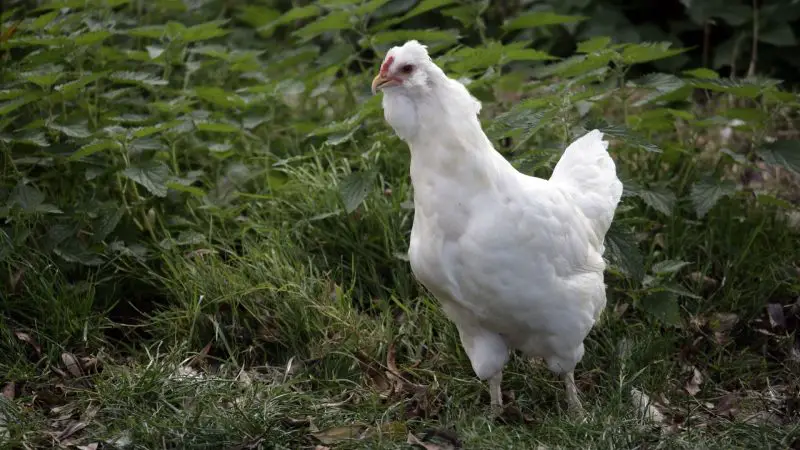
Araucana originated from Chile in South America. They were brought to the United States in the 1930s and have been crossed with other breeds. This breed was formally acknowledged by the American Poultry Association in the 1970s.
This fowl has an upright posture with a downward sloping back as it doesn’t have feathers on its tail. It also has some distinctive tufts on one or both sides of its cheeks that add to its striking appearance. The Araucana is also one of a few breeds that produce blue eggs.
Best For:
Araucana is bred mainly for ornamental purposes due to its unique physique and blue eggs. Producing around 150 eggs per year, they are certainly not prolific layers, though they can still be kept for their eggs. They are also crossed with other breeds to produce new breeds and are usually referred to as “Easter Egger Chickens.”
3. White Ameraucana
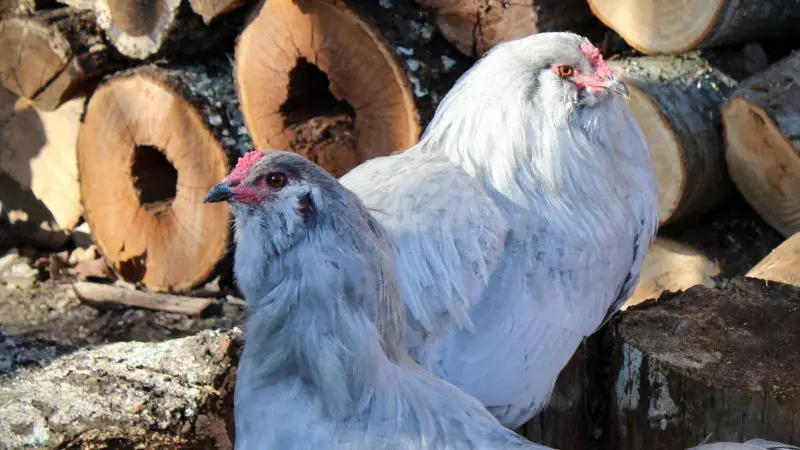
The White Ameraucana was developed from the Araucana in the 1970s. They were created to be a breed that produced the blue eggs of the Araucana but had a tail. Ameraucanas are also referred to as “Easter Egger Chickens.”
White Ameraucana have white feathers, and their heads have whiskers and muffs. They also have grey legs and quickly adapt to new environments. The fowl are also not aggressive and are mostly calm.
Being descendants of the Araucana, these fowl also lay blue eggs. However, they have a full tail and aren’t rumpless like the Araucana.
Best For:
White Ameraucanas tend to lay attractive blue eggs, usually medium to large and can produce around 200 eggs each year. Though white Ameraucanas are not kept for specific purposes, their blue eggs make them appealing and can also be kept for their meat.
4. Rhode Island White Chicken
The Rhode Island White came from Rhode Island in the U.S. This breed is a cross of white Wyandottes, Partridge Cochins, and Rose Comb White Leghorns.
Apart from the apparent white plumage, this breed greatly resembles their cousins, the Rhode Island Reds. Males can weigh around eight pounds (3.62 kg), while females weigh around six pounds (2.72 kg).
Despite their large size, Rhode Island Whites have a calm and non-aggressive temperament.
Best For:
With their large size and weight, these fowl have an excellent body meat content. These birds are also prodigious layers, producing around 240 eggs in a year, which explains why they’re kept for both their meat and eggs.
5. California White Chicken
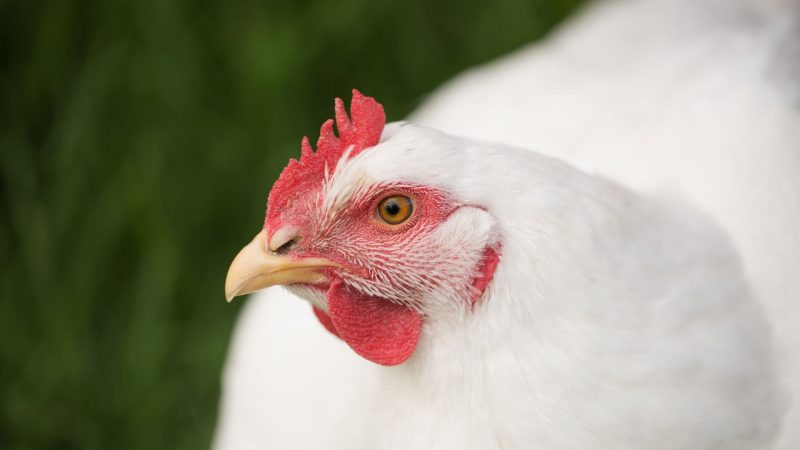
California White chickens are a crossbreed of the California Grey chicken and the White Leghorn chicken.
This fowl is predominantly white, with just a few black specks on its feathers. It takes after the White Leghorn’s incredible physique and the calmness and hardiness of the Barred Plymouths, from which the California Grey descends.
Speaking of hardiness, California White chickens can withstand both cool and warm climates, a quality that makes them a favorite of commercial breeders. Provided you take good care of the California White chicken in terms of grooming and diet, this breed will serve you for years, laying eggs consistently throughout the seasons.
Best For:
This fowl takes after the White Leghorn’s egg-laying capabilities and can produce around 300 eggs a year. The size and quantity of California White chickens’ eggs aren’t affected by changes in seasons. Their calm demeanor makes them easy to care for, as well.
6. Yokohama Chicken
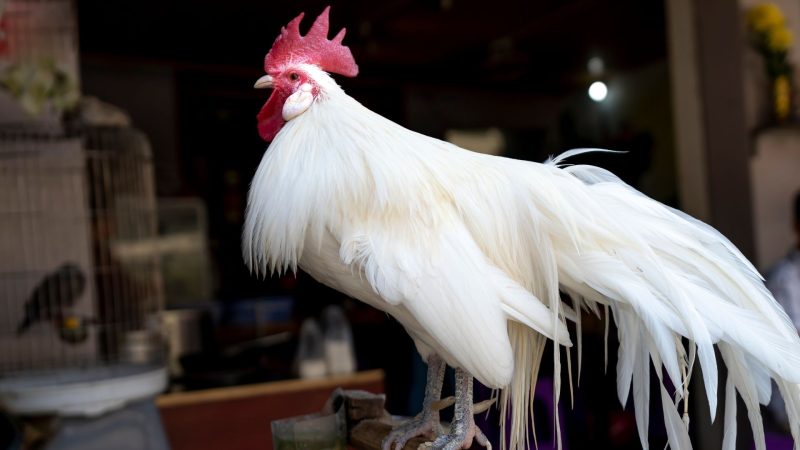
The Yokohama chickens have their roots in Japan, where they were exported to Paris from Yokohama Port and were initially called the Minohiki.
Present-day Yokohamas are a crossbreed between the Malay Phoenix, the common game fowl, the Sumatra fowl, and the original Yokohamas. The American Poultry Association recognized them in 1981.
From the first look, one can attest to how fancy these birds are. They have elegant feathers with an upright structure that adds to their overall attractiveness. This breed resembles the Sumatra chicken, which has long flowing bodies, though Yokohamas have longer tail feathers.
The breed also likes to wander long distances and can easily thrive when bred on large farms.
Best For:
Yokohamas aren’t the heaviest breed as they have low meat content. These chickens tend to lay around 80 – 100 eggs yearly, which is low compared to other breeds. For this reason, these characteristics make the Yokohamas ideal ornamental bird. Keeping Yokohamas as the only chicken in your coop isn’t recommended as they thrive when kept with other non-aggressive chickens.
7. Sultan Chicken
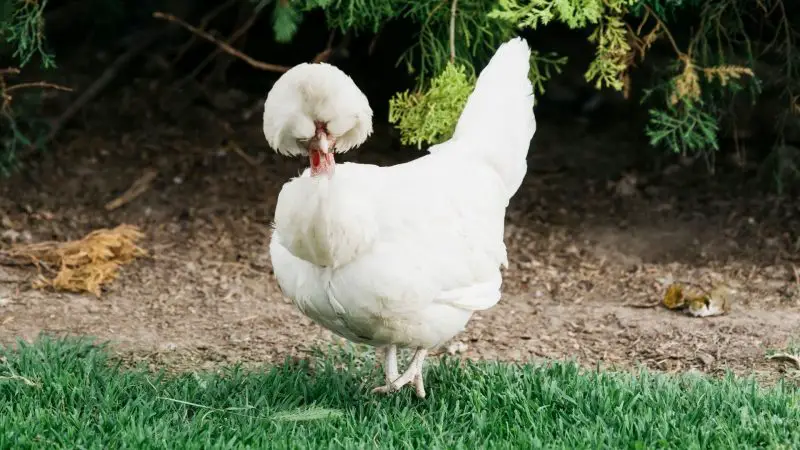
Sultan Chickens are also known as Serai-Tavuk in Turkey, where they originate from, meaning “Fowls of the Sultan.” As the name suggests, the fowl were kept by Turkish royals in Constantinople (Istanbul) in the Roman Empire.
Sultans are large bearded, crested, and are among the few bird species having five toes. These birds are extremely rare but tend to thrive when kept with other non-aggressive chicken breeds.
Like their plumage, Sultan eggs also have white eggshells and have feathered feet and shanks. They also have a comb that’s v-shaped and low-placed wings that cover their thighs.
Best For:
Despite its overall large size, the Sultan chicken is primarily kept for ornamental purposes due to its striking looks. Because it only lays around 60 eggs annually, and those eggs are relatively small in nature – it’s an unattractive chicken in terms of egg production.
Related: Frizzle Chicken | Unexpected Wonders and Surprising Perks!
8. White Plymouth Rock Chicken
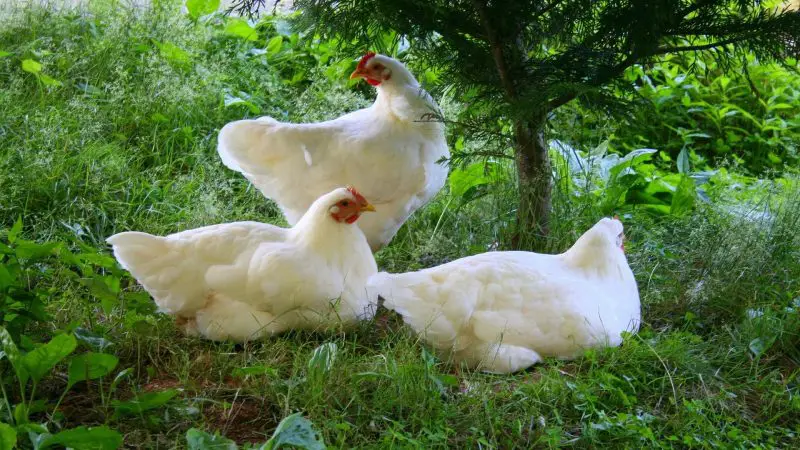
Plymouth Rocks were introduced in 1829 at the first poultry show in America. However, present-day fowls were crosses of various breeds, including the Cochin, Java, Dominique, and Brahma fowls.
This breed is a hardy and calm chicken breed with a solid white appearance. It is broody, often sitting on its eggs and those of other chicken breeds. The fowl has a broad, long back and a single, moderately-sized comb.
Best For:
The Plymouth Rock is reared for both its meat and eggs. It lays over 200 eggs yearly, which are large and brown. An adult Plymouth Rock is larger and heavier than most other chicken breeds, which makes it an ideal breed for meat production, as well.
Related: Black and White Chicken Breeds | Information and Facts
